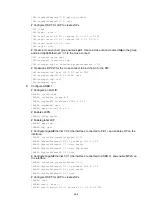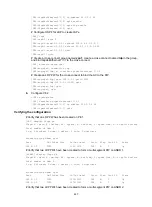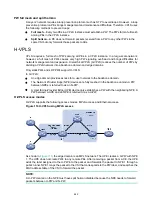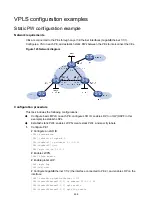
446
NOTE:
When VLANs are globally unique, packets with the same VLAN ID are forwarded by the same VSI
regardless of the receiving interfaces. If VLANs are unique on a per interface basis, packets with the
same VLAN ID from different interfaces can be forwarded by different VSIs.
Configuring a Layer 3 interface
To create a Layer 2 link between a PE and a CE, configure the Layer 3 interface that connects the PE
to the CE.
The Layer 3 interface can be a Layer 3 Ethernet interface (including physical Layer 3 Ethernet
interface and VE-L2VPN interface) or Layer 3 Ethernet subinterface.
For more information about Ethernet interfaces, see
Interface Configuration Guide
. For more
information about VE-L2VPN interfaces, see "Configuring L2VPN access to L3VPN or IP backbone."
Configuring a VSI
Step Command
Remarks
1.
Enter system view.
system-view
N/A
2.
Create a VSI and enter VSI
view.
vsi
vsi-name
[
hub-spoke
]
By default, no VSIs exist.
If you specify the
hub-spoke
keyword for a VSI, the VSI
supports the hub-spoke network
model.
3.
(Optional.) Configure a
description for the VSI.
description
text
By default, no description is
configured for a VSI.
4.
(Optional.) Set the default
PW ID for the VSI.
default-pw-id
default-pw-id
By default, no default PW ID is
configured for the VSI.
5.
Set an MTU for the VSI.
mtu
size
By default, the MTU of a VSI is
1500 bytes.
6.
(Optional.) Enable the VSI.
undo shutdown
By default, a VSI is enabled.
Configuring a PW
Configuring a PW class
In a PW class, you can configure PW attributes such as the PW data encapsulation type, and
whether to enable control word. To simplify PW configuration, you can configure PWs with the same
attributes by referencing the same PW class.
To configure a PW class:
Step Command
Remarks
1.
Enter system view.
system-view
N/A
2.
Create a PW class and enter
PW class view.
pw-class
class-name
By default, no PW classes exist.
3.
(Optional.) Enable control
word.
control-word enable
By default, control word is
disabled.






























